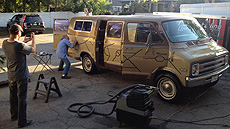Saving the Feynman van
 |
A team of Richard Feynman's friends and fans banded together to restore the Nobel laureate's most famous vehicle. Photo courtesy of Seamus Blackley |
"The game I play is a very interesting one," says Nobel Laureate Richard Feynman in a low-resolution video posted to YouTube. "It's imagination in a tight straitjacket."
Feynman is describing his job as a theoretical physicist: to lay out what humanity knows about how the world works and to search the spaces in between for what we might have missed.
The video shows more than Feynman's way with words. It shows his approachability. One of the greatest minds that particle physics has ever known stands barefoot, lecturing in a distinct Queens, New York, accent for an audience lounging casually on the floor at the new-age Esalen Institute in Big Sur, California.
In a way, Feynman remains approachable to this day for all of the snippets of his personality left behind in books, letters and recordings of formal and informal lectures and interviews.
Recently, a more concrete bit of Feynman history came out of retirement: A small team has brought back to life the so-called "Feynman van."
One camper, special order
In 1975, Feynman and his wife, Gweneth Howarth, bought a Dodge Tradesman Maxivan and had it painted with Feynman diagrams, symbols Feynman had invented to express complicated particle interactions through simple lines and loops.
It might seem arrogant to drive around in a van covered in reminders of one's own intellectual prowess. But Feynman's daughter, Michelle, thinks the decorations represented something else: a love of physics.
"My dad was pretty low-key about himself," she says. "I think decorating the van was more to celebrate the diagrams than to celebrate himself."
Michelle's parents put a lot of thought into the design of the vehicle, which they primarily used for camping, Michelle says. It was outfitted with a small hammock for Michelle to use in case the family of four needed to sleep inside during inclement weather.
"I don't think that they had ever done anything like that with a car purchase before," Michelle says. "It was always: Go to the dealer and find something — it doesn't really matter what color it is — and you'll have it for a million years."
The Feynman family took the van to Canada, Mexico and dozens of US campsites in between, often traveling with a couple of other families, often leaving the paved road for the unknown.
Michelle began driving the van to school after she turned 16.
"I thought it was kind of embarrassing," she says. "But at a certain point I kind of got over it. If you want to drive at that age, you'll drive anything."
After Michelle's first couple of years in college, one of her father's friends, film producer Ralph Leighton — Feynman's drumming partner in another famous fuzzy YouTube clip — bought the van and put it into storage, where it began to rust and fade.
Read more
—Kathryn Jepsen
|